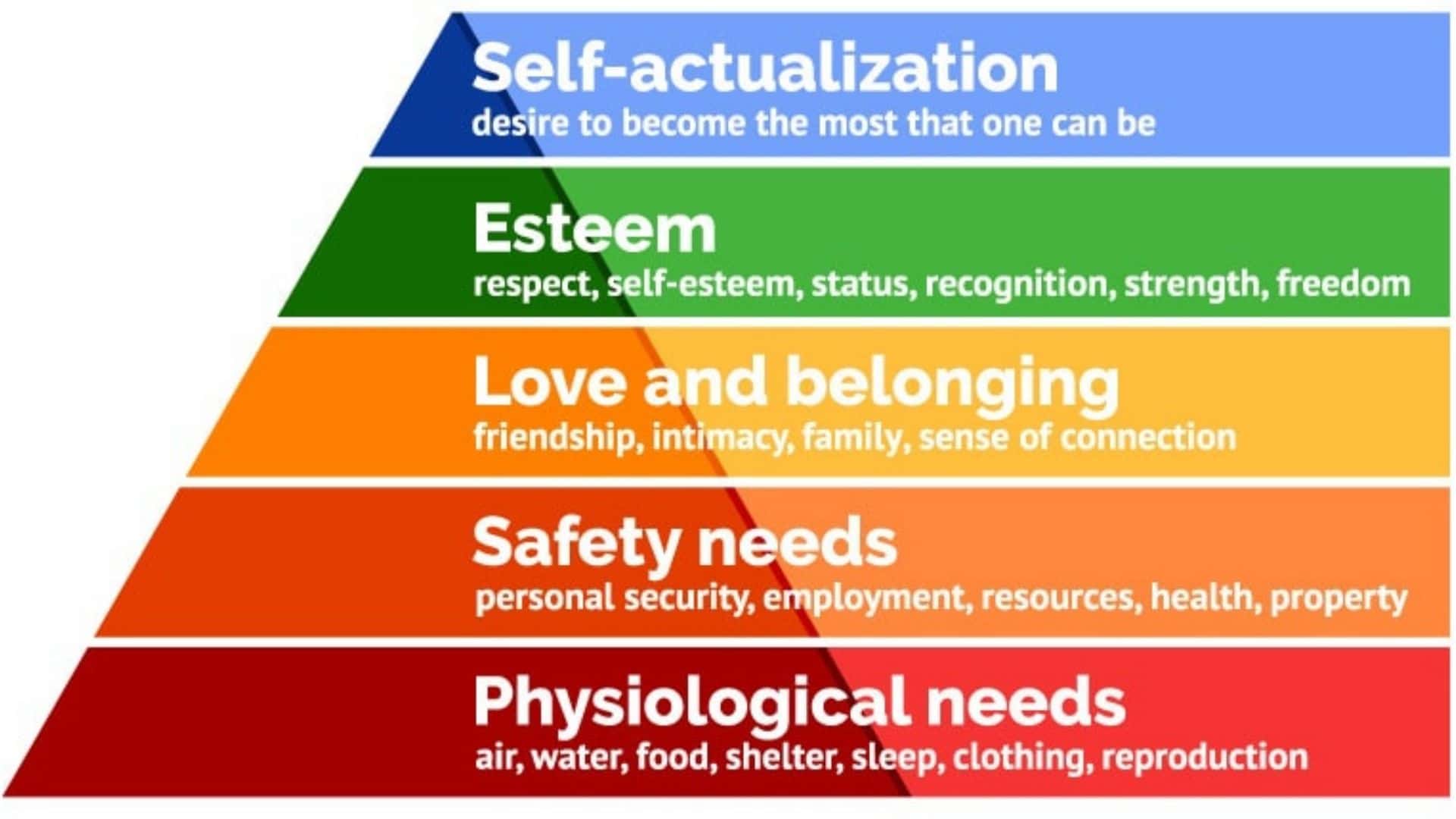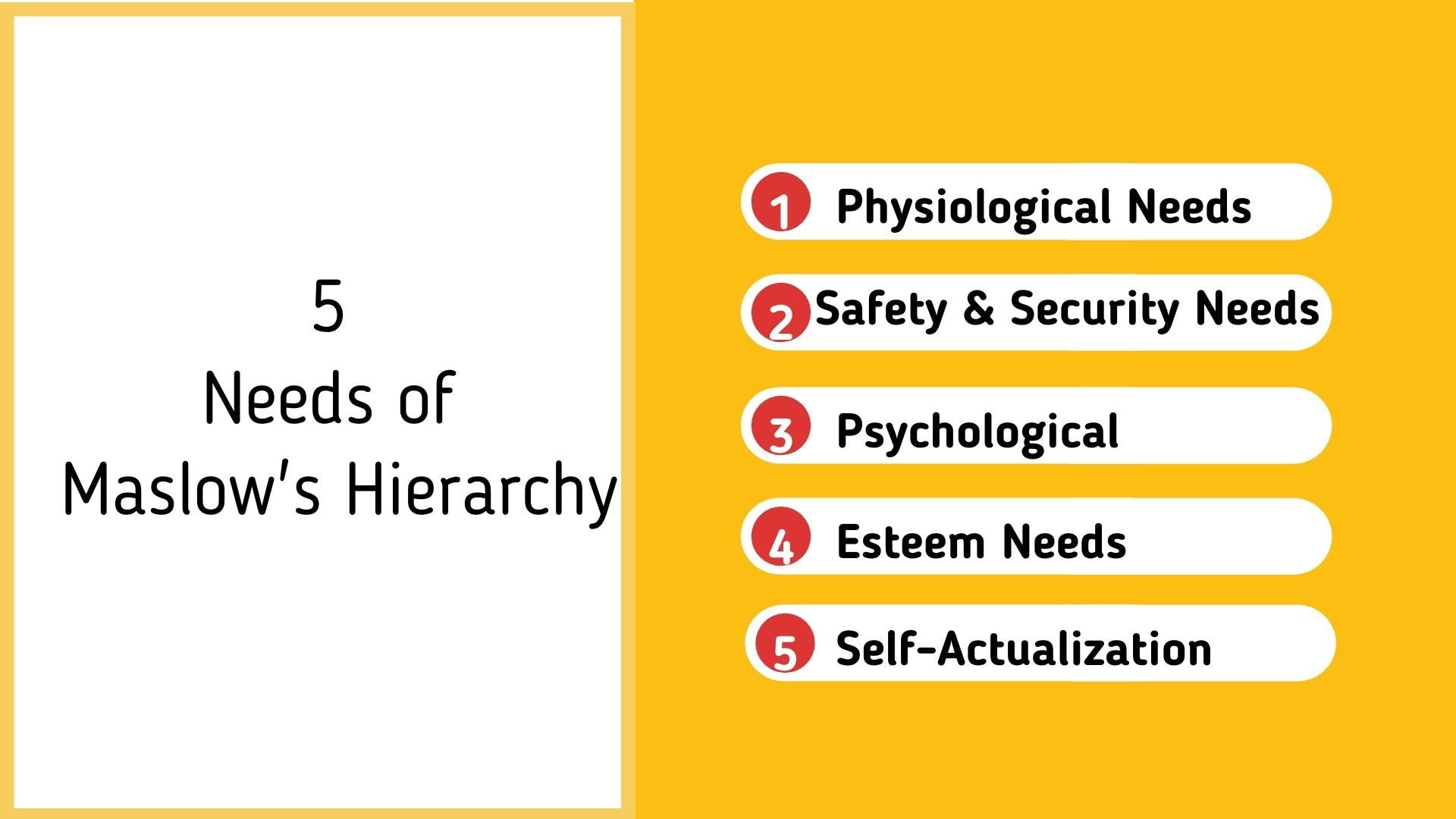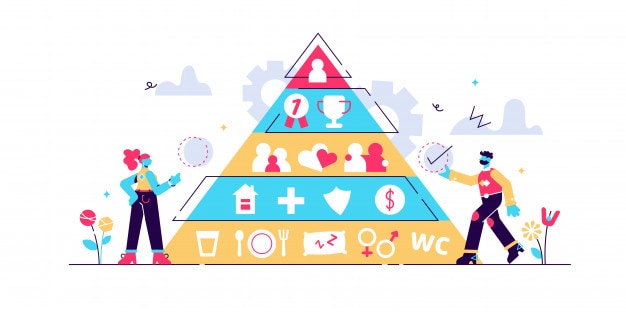Maslow’s hierarchy of needs revolves around a theory of understanding how human motivation works.
What are the basic needs of a human? Food, water, clothes, and shelter!
– Probably, this is going to be your answer as well. What if you have an abundance of these?
You develop new needs or say your needs are now at a higher level. This psychology forms the base of Maslow’s Hierarchy of Needs. Our needs have been arranged in a hierarchical order by great psychologist Abraham Maslow.
As indicated by Maslow’s hierarchy, we human being tend to reach our fullest potential if 5 of the key needs are met-
- Physiological Needs
- Safety Needs
- Psychological Needs for love, adoration, and fondness
- Esteem Needs
- Self Actualization
The motivation of human beings fluctuates every moment.
At times it is tough to complete an essential task; then again, some of the highly tough undertakings are done handled without any problem.
So, the accomplishment of a task depends upon numerous variables: abilities, energy level, experience, the ambiance around, and so forth. Be that as it may, the most significant factor is – Motivation. – It is something that pushes us towards our objective.
In case you are motivated for some activity, you will be working by being more tenacious with absolute perseverance. You will work longer than expected. While on the other hand, if you are not motivated, completing the same task would become troublesome. You will be coming up with different excuses for delaying the task.
This post will take you deep into Maslow’s Hierarchy of Needs to help you understand how motivation channelizes our working styles. So, let us start unfolding the mystery here and now-
Table of Contents
Introduction to Maslow’s Hierarchy of Needs
Abraham Maslow is known as one of the most incredible proponents of adding a human touch to the investigation of brain science and human psychology.
The concept of the hierarchy of needs was first introduced by Abraham Maslow in his research paper – “A theory of human motivation,” which was published in 1943. He also mentioned it in his book – “Motivation and Personality.” According to Maslow – people feel motivated enough to fulfill their basic needs at first, and once those are met, new needs arise.
According to Maslow, humans have a strong desire to be everything that they can be. People want to achieve everything that feels possible for them. But before that, they had to fulfill some basic needs – food, safety, relationship, social status, etc. Maslow has put all our needs in a hierarchical order, which contains five levels.
Why Understanding Maslow’s Hierarchy of Needs is Important
Though this theory was entirely psychological, its application is widely witnessed in the management domain. The managers use the theory to understand the needs of their employees and provide them with the satisfaction that they seek. Its application is wide in the 20th century as business managers invest in more to understand their employee’s needs better.
He likewise put together a large portion of his Hierarchy of Needs theory on motivation and training as per the study of sound and successful people like Albert Einstein and Eleanor Roosevelt. They accomplished overall admiration for their intelligence and humanity.
The hierarchy of needs theory of Maslow recognized the different needs that a person needs to support him/her to accomplish his/her absolute potential. Maslow’s theory should be deliberately understood by all instructors, social instructors, educators, HR managers, etc. for understanding human behaviors.
The theory is communicated as far as a chain of importance via a hierarchy; in any case, it can also be understood in a parallel manner as all these needs can be equally essential to lead a healthy and constructively motivated life.
All in all, motivation is the most significant factor for excellent performance and goal accomplishment. Notwithstanding education, training, and experience, without a legitimate degree of motivation, one’s performance won’t be as good as it could be with motivation.
For instance, an increase in salary can be a solid motivation, but just for the limited time. When someone gets a hike, he or she will stay motivated for quite a while, but, sooner or later, the new salary level won’t motivate him or her anymore, because the individual will have adapted to another level.
Some of the key applications of Maslow’s theory are-
- Maslow’s theory of need gained immense popularity and was also followed by several groups from different domains as well. It helped in explaining human psychology better. Though the theory was not backed by enough science, and the research was also conducted on a limited scale, the application of the theory was huge.
- Not only in terms of psychology, but it has attracted people from different domains and its applications are also vast. The self-actualization need explained, in theory, lacks a lot of evidence and proper explanation and even fails on certain occasions, except that the theory gained remarkable attention and recognition from various sectors.
- Most importantly, it helped the managers better understand their employees’ psychology. It also helped in the teaching programs. The theory is widely used in the business domain. For example – a hungry and tired individual will first focus on his/her food and rest rather than the work. He/she will care less about social status and concentrate more on his/her health.
Let us now understand the concepts of Maslow’s Hierarchy Theory with an example-
Example of Man’s Needs as indicated by Maslow Hierarchy
Fourteen-year-old Angelina is an extraordinarily gifted and one-of-a-kind child. She figured out how to do the reading at four years old and was diving into Shakespeare when she was eight.
She performed excellently in her academics, and now she is at the top of her class. Since she is the best, she is sent continuously to different sorts of competitions. She is likewise musically slanted and plays various instruments, for example, the piano, flute, and violin.
She participates in the local orchestra and performs with them in shows. Also, she does ballet and tap moves along with some singing and acting. She is also a member of the local theater group. In addition to all this, she is exceptionally deft and agile. She beats all the young boys in her class.
Seeing her doing all these things, anyone might think that due to all the things that Angelina does, she would feel exhausted, pressured, and gloomy.
But, in all actuality, however, she feels the reverse.
She is bubbly, upbeat, and positive.
At the point when individuals ask her what her mystery is, she discloses to them that her genes may have given her the ability, skills gifts. Yet, her happiness, satisfaction, and positive thinking are all a result of the hierarchy of needs suggested by Abraham Maslow.
She suggests the hierarchy implies that we must satisfy the basic needs before we move to another level of needs.
So, as a psychologist, Abraham Maslow made a series of human needs that, as indicated by him, must be accomplished by individuals with the end goal for them to arrive at self-actualization.
Maslow’s hierarchy of needs is portrayed as a five-leveled pyramid- in which the lowest level of the pyramid is the most fundamental or basic needs. In contrast, the top-most level talks about the most complex needs.
Abraham Maslow created this theory regarding the hierarchy of needs for clarifying the multifaceted nature of human motivation.
Pyramid of needs as per Maslow’s Hierarchy
When Maslow explained his theory, it never mentioned any pyramidical format.
Maslow put the theory in his research paper and the book. Later, a pyramidical format was given to the theory, and needs were put in those pyramids. The base of the pyramid displayed basic needs, and as you go up on the pyramid, you reach the next level of your needs.
You can also understand it this way – as you go up the pyramid, the complexity of needs increases. The base of the pyramid comprises basic and simple needs like – food, safety, shelter, etc. Whereas the upper level includes more complicated needs like – social status, self-esteem, and so on.
Once you have an abundance of food, safety, shelter, and all, you start feeling like love and relationship are important. Once you get that, you start feeling like your social status is highly important. You never feel satisfied unless you have achieved actualization. Once you get to the top of the pyramid – you have everything that you could ever wish for.
As discussed above, the five levels of needs explained by Abraham Maslow are as follows –
- Physiological needs
- Safety Needs
- Love and Belonging
- Esteem
- Self-actualization
Here the physiological need is at the base of the pyramid, whereas self-actualization lies at the top. Let’s understand these, one by one in detail –
5 Needs of Maslow’s Hierarchy
1. Physiological Needs
These are the basic needs of every human. This is what you can’t survive without. The very basic needs that are important for our survival are mentioned in this group. For example, physiological needs are –
- Food
- Water
- Air
- Sleep
- Shelter
- Sex
- Discharge
These are some of the necessities that you aspire to fulfill. Maslow also included sexual reproduction in this group, as that is essential for the survival of species.
When these needs aren’t fulfilled, you get displeased. Moreover, you feel no motivation to fulfill the needs of a higher-level, like safety and relationship. Once these needs are met, humans aspire for the next level of needs –
2. Safety and Security Needs
In the modern era, both physiological and safety needs are termed as the basic needs for human survival. Once our physiological, i.e., simplest needs are met, we move to the next level, i.e., more complex needs. Here on this level, safety and security become our primary needs.
From health and wellness to financial security, everything falls under this domain.
As per Abraham Maslow, people will be motivated towards their safety and security needs only if their physiological needs are met in the first place. Here’s an example of safety and security needs
- Health and wellness
- Safety against injuries and accidents
- Financial security
- Business security
- Property
You must have got an idea of what we mean by safety and security needs. It also includes – job security, health insurance, money in your savings account, living in safe surroundings, and so on.
In modern era, these have become the primary needs of humans. We can survive without these, but that survival won’t mean anything, and we will feel displeased most of the time.
3. Psychological Needs (Love and belonging)
This level of needs in the hierarchy explained by Abraham Maslow is purely based on human emotions. The needs that arise during this stage are the cause of our emotions.
Once the primary needs are satisfied, our emotions start driving our behavior. Needs like – love, relationship, intimacy, belonging, etc. star arising at this level.
People start to feel that they must be socially connected; hence they seek friendship/relationship from others. Abraham Maslow has also included an intimate relationship in this group as he describes – it is the need of humans to have intimacy with their choice of partner.
Some of the examples of needs falling in this group are as follows
- Friendships
- Relationships
- Family
- Romantic attachments
- Intimate relationships
- Community engagement
- Religious engagements
The needs mentioned above are all related to the social needs of any person. Human is a social animal, and that is what Maslow has explained through this group of needs.
According to him, humans have the urge to love others and be loved by others. Failing to this will make their life dull, boring, and full of loneliness. These factors further cause severe health issues like – anxiety and depression.
Abraham Maslow has also emphasized engagement with religious groups, sports teams, different clubs, and so on. The prime objective of these needs is to draw humans closer to society and make all of them connected to each other somehow. To battle, various mental illnesses one needs to emphasize on these needs.
4. Esteem Needs
In his hierarchy of needs, Abraham Maslow has emphasized the need for esteem. According to him, humans want appreciation, they want to be respected in society, and they want to have their status.
Once the needs at the previous levels are fulfilled, people strive for esteem. We all make efforts to accomplish our goals, but after that, we all want recognition in society.
We all make small or big contributions to the land where we live. We make our individual efforts for those contributions. Now, it is the nature of humans to seek recognition for those contributions.
We want to be respected by others for what we have accomplished.
The respect and appreciation of others become a primary need at this stage. Abraham Maslow has also emphasized self-esteem, self-respect, and personal worth. Some examples of such needs are
- Social respect
- Social status
- Recognition
- Appreciation by others
- Self-esteem
- Self-worth
These are the needs without which people don’t gain the confidence required for leading life. For meeting these needs, people participate in various professional activities, go for multiple competitions, and work on personal hobbies.
Those who are successful in their endeavors to achieve respect and a positive social status feel confident about everything they do subsequently. People who fail to do so develop an inferiority complex. This directly affects their approach to a different life and professional problems.
Abraham Maslow has also emphasized on personal-worth and self-esteem a lot. Here he has focused on not forgetting the moral values while stretching to any professional deeds.
People should be in a position where they respect their accomplishments. Here, Abraham Maslow has entirely focused on the psychological needs for survival.
5. Self-Actualization
Once you have completed all the levels in the hierarchy, you move to this step. This is top-level in the pyramid. Abraham Maslow defined this level as – “What a man can be, he must be.” Humans always try to achieve whatever they can. In this stage, humans try to use their full potential to achieve the most complex goals.
People try to do the best they can do. Here in this stage, the focus of people relies entirely on themselves. They don’t care about what others think. The examples of needs falling in this domain are as follows –
- Pursuing goals
- Parenting
- Seeking personal fulfillment and happiness
- Self-satisfaction
These are the 5-levels in the pyramid of the hierarchy of needs explained by Abraham Maslow. Maslow has further grouped these 5-levels of needs into different groups.
Here is a video by Marketing91 on Maslow’s Hierarchy of Needs.
Deficiency needs and Growth needs according to Maslow
According to Maslow, the needs explained in the hierarchy are necessary for one’s survival as well as one behavior and motivation. Physiological, security, social, and esteem needs are termed deficiency needs.
These needs only arise when a person is deprived of those. The needs at the lower level of the hierarchy are a must to achieve as not-fulfilling those will cause unpleasing feelings, and the person will feel dissatisfied.
The highest level of need in the hierarchy or self-actualization is termed as growth need. This is something that is not a result of any deprivation; rather, it is the result of a wish. Moreover, Maslow also explained that people might not follow the sequence, as mentioned in the hierarchy.
For some, the social status might be more important than safety and security. Hence, Maslow has categorized the needs of these two groups.
Criticism of Maslow’s theory of Needs
Undoubtedly, the hierarchy theory from Abraham Maslow became extremely popular, but it also caught up several criticisms as well. The application of this theory is huge in the business and management domain. Following are the main criticism that this theory caught up –
1. The sequence is not followed
According to Wahba and Bridwell, Maslow has not given enough evidence to support his theory. At first, there is less evidence supporting the fact that these needs occur.
Then there is lesser evidence to support that this hierarchy is followed. People may not feel the demand in the same order.
2. Not scientific
Many criticisms on the theory rose due to its lesser association with the science. The self-actualization need is not easy to test scientifically. Moreover, the research that Maslow conducted was not on a huge scale; rather, he picked a few individuals only, and the selection was not random.
The major drawback of the theory was that the needs not always follow the hierarchy. People who are deprived of their basic needs might still focus on their social status.
The primary reason for this drawback was the small sample size that Maslow picked for the research. However, the needs that are explained in theory do exist but always in the hierarchical order.
Final Thoughts!
Abraham Maslow’s theory of the hierarchy of needs is though old yet highly useful in the modern era. It helps in personal development as well as business growth. It helps in understanding what people want and what drives their motivation.
It will help you in understanding different sorts of needs at different levels whose fulfillment works as the motivation that ultimately driven an individual to perform a task with full enthusiasm or without enthusiasm.
Do you also find Maslow’s Hierarchy of needs exactly describe how our motivation works at the different stages of life?
Do you have some instances to share the implications of Maslow’s hierarchy from your professional or personal life? Then feel free to share with us in the comment section below.
Liked this post? Check out the complete series on Motivation


